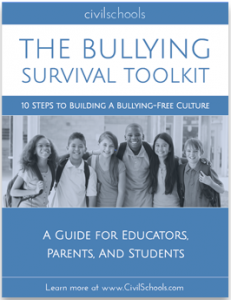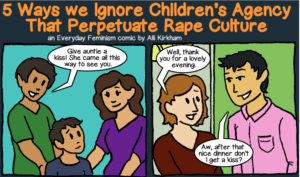
Source: Mastering Teaching
If you’re a parent of a school-aged child, it’s likely that you’ve been affected by bullying.
With approximately 30% of students reporting being bullied and far more being peripherally affected or even traumatized by bullying, it’s a weighing concern on parents’ minds.
I often will meet parents when I’m out at a party or on a long flight who, when they hear that I’m a bullying-prevention educator, immediately begin to impart their terrible story of childhood trauma and abuse or stories about their kids being bullied in school.
And while just about every parent cares passionately and deeply about ending bullying, most are unsure of what they can do to protect their child.
That’s one of the reasons that I partnered with Everyday Feminism a few months ago to facilitate a free webinar on how parents can intervene to end bullying.
Knowing that not every parent has an hour to sit down and watch the recording of our webinar, though, I wanted to offer a quick read for parents who are concerned about bullying.
Understanding Modern Bullying
Before parents can effectively intervene when bullying is taking place, it’s important that we understand a few things about the nature of modern bullying.
First, a comprehensive review of the research on bullying from the American Educational Research Association tells us that “bullying is often aimed at specific groups” and is often a direct result of power imbalances.
In short, bullying is primarily a problem of power, not simply random childhood cruelty.
Though not every instance of bullying is directly related to identity, research indicates that it can be important to talk about bullying through the lens of identity.
Second, the nature of bullying has changed tremendously in the last 15 years.
I often have adults say to me, “Man, I was bullied, and I survived! All this coddling isn’t going to help kids toughen up!”
My response is always, “While I’m really sorry that you were bullied, we also need to understand that bullying today isn’t the same thing as bullying when we were young.”
In my own case, I was bullied pretty terribly in my youth.
It got to the point that I felt pretty desperate and even suicidal at times. And this was in a time when I was able to take breaks from the bullying.
You see, when I got home from school, the bullying stopped. And every summer break, I got a two-month reprieve from the bullying behavior. And I barely survived!
Today, with the wide accessibility of cell phones and the Internet, bullying can be near constant.
One of the last things young people with cell phones do before bed and first things they do when waking up is check their phone. If they’re being bullied through Twitter or text, that’s how they will start their day.
The scary thing about cyber bullying is that it never takes a break.
Knowing these two things about bullying will help tremendously as you look for the ways to best support your child and intervene when they are being targeted for bullying.
1. Look for Signs of Bullying
Though it may seem obvious, many of the signs of bullying go unnoticed or written off as moodiness or growing pains.
But there are concrete things that you can look for that will help you to identify when you child is being bullied.
No matter your child’s age, ask yourself these questions:
Has your child…
…stopped doing things that they enjoy?
Students who are being bullied tend to express greater self-consciousness, and as a result, they may suddenly stop doing things they enjoy.
Maybe they’re being mistreated at baseball practice, so they no longer want to play baseball. Maybe they’re being bullied for their interest in Magic the Gathering, so they suddenly stop playing the game that they love.
…expressed a sudden or progressive sad or sullen attitude?
Maybe this is a sign of seasonal affectedness, or maybe this is because the teasing has finally broken through your child’s defenses. Once the poison of bullying gets inside, it often will show up through progressive or sudden sadness.
…expressed a sudden or progressive angry attitude?
Similarly, bullying can also lead to sudden outbursts of anger.
This is important to recognize because it can often end up leading to your child “passing on the hurt” by bullying other people.
For me, I was terrible to my parents and best friends when I was being bullied in middle school.
…expressed sudden or progressive self consciousness about their identity?
Because much bullying is identity-based, it can lead to students feeling more self-conscious about the aspect of their identity that is being targeted.
In the case of heterosexist/homophobic bullying, it can lead targeted kids to express self-consciousness and to project their understandings of heterosexuality in extreme ways.
…been reluctant or afraid to attend school or activities?
Maybe they’re just hitting that time of year when nothing can make them want to go to school, or maybe they’re being mistreated in some way. But sudden reluctance to attend school or activities is a good sign that bullying could be taking place.
If your answer to any of these questions is yes, talk to your child.
The more open and honest you are with them about your concern, the more likely they will be to talk to you about what’s hurting them.
And even if they don’t end up sharing everything with you right then and there, bringing it up helps them understand that they can come to you for help.
2. Engage Your Child’s Digital World
If your child is not yet online or using a cell phone, it’s only a matter of time. So it’s important to set a precedent early about how you will engage with their digital world.
Sadly, cyber bullying is on the rise and is becoming one of the key tools in bullying behavior.
You have to decide for yourself how involved you feel comfortable being, but being involved is without a question vital to intervening if your child is being bullied or demonstrating bullying behavior.
Ask yourself whether you’d feel comfortable knowing your kids’ passwords and until what age? Have you talked to them about web safety? To what degree are your kids trusted with unsupervised use of cell phones or the Internet?
All of these questions are vitally important.
Do you know all of the different social media apps your kids might be using?
One thing that was surprising to me is that I consider myself pretty “in the know” when it comes to the digital world. Yet when I was doing research for the CivilSchools parent workbook and polled high school students about what apps or platforms they’re using, a number came up that I had never heard of!
Young people are fleeing Facebook for Twitter, WhatsApp, Snapchat, Ask.fm, Tumblr, Lulu, Whisper, and other platforms.
It’s important, then, to have an open and honest dialogue about what kinds of social media they engage with and how they engage, reminding them that if they or anyone they know is being mistreated, they can talk to you or other trusted adults.
3. Self Reflect
One of the hardest things for parents to realize is that bullying behavior is learned. Therefore, if you’re concerned about eradicating bullying behavior from your community, you need to start in your own home.
In her fantastic reflection on learned bullying behavior, Rachel from Hands Free Mama astutely realized that the biggest bully in her daughter’s life was herself.
One of the best things we can do to prevent bullying is to think about the ways that we might be teaching bullying behavior to our kids.
Do we talk badly about other people or identities? Do we demonstrate that it’s okay to say terrible things to others (perhaps through our road rage or in how we treat service employees)?
4. Build a Parenting Network
In the midst of our busy lives, parents are becoming increasingly disconnected from other parents in their children’s school community. Yet parent allies are some of the best people to step in and help when you fear your child is being bullied or demonstrating bullying behavior.
Does your community have a parent advocacy organization? If not, what would it take to start one and get other parents to join?
Having a parent advocacy network doesn’t require a ton of extra time or meetings on the schedule. Parent listservs or Facebook groups make it easy in our busy schedules to reach out to other parents.
Sometimes a simple message like “I’ve been noticing my child’s been more and more angry lately, and I’m wondering if something’s going on at school” can alert other parents who may be having the same problem, and you can start to get to the bottom of it together.
Plus, if you suspect bullying is taking place, a parenting network might help you reach out to the parents of children you suspect are exhibiting bullying behavior.
There’s a chance those parents will be defensive and you’ll have to go through the school, but if there’s even a small chance that alerting an unaware parent might stop the problem, a parenting network can be the thing that saves the life of a bullied young person.
5. Build a Proactive Relationship with Your School
Sadly, if the first time that your kid’s school hears from you is when you come in furious that they’re doing nothing about the bullying your child is experiencing, they’re far more likely to write you off. I wish it weren’t true, but it is.
If you’re worried about bullying, one of the best things you can do is start building a proactive relationship with the school early.
Identify who your allies are in the building, and reach out to them early offering your help and support. That way, when you reach out for help and support with bullying, you’ve got some people in your corner.
Additionally, teaming up with other parents to both show that you support your school and teachers and to draw attention to bullying behavior is important.
Schools are likely to take you more seriously when they realize bullying is a problem that is affecting more than one family.
Finally, when working with your kids’ school, assume best intentions on the part of teachers and staff, but do not hesitate to get forceful to make your voice heard. Your child has a legal and ethical right to feel safe and included in their school environment.
6. Demand a Comprehensive Approach to Bullying
One of the reasons that I originally designed the CivilSchools program is that research tells us that bullying is preventable, but only when the entire community – parents, teachers, students, administrators, and the wider community – is engaged.
Whether it’s a program like CivilSchools or something else, there needs to be mechanisms to engage the entire community if you truly want to build the kind of community where bullying is no longer present and where all students feel safe.
A recent national study indicates that only half of school employees have received training in how to prevent bullying, and more than half of school staff say they need additional training.
Unfortunately, though, with the laser-like focus on reading strategies and math concepts (which are important – don’t get me wrong), schools don’t often prioritize the time and money it takes to actually involve everyone in bullying prevention until there is some sort of tragedy.
But schools tend to listen to parents.
If a bunch of parents from your parent advocacy network start e-mailing the principal, demanding a comprehensive approach to bullying, it will happen.
Bullying By Any Other Name…
Sadly, the term “bullying” has been used as a catchall recently, thus watering down the term and making it far less effective for describing the actual problem at hand.
But one thing we know is that when you describe specific bullying behaviors to students and ask them to identify the ones that are present in their schools, we know that bullying is a problem that ain’t going away simply because we’ve passed some “zero-tolerance” laws (PS: They don’t work!).
Building bullying-free school culture and climate where every student feels safe and inclusive is hard work that requires parent engagement. The more organized and tenacious you are about demanding a safe and inclusive environment in your school, the more schools will have to listen.
The more we demand social-emotional learning that teaches empathy and the more we equip our community members with tools to actually prevent bullying, the greater a change we will see.
But don’t forget: Bullying is preventable if we engage the entire community in building more inclusive school environments.
***
Click here to receive your free Bullying Survival Toolkit: 10 Steps to Building a Bullying-Free Culture for actions you can start to take today!
***
Want to discuss this further? Login to our online forum and start a post! If you’re not already registered as a forum user, please register first here.
Jamie Utt is a Contributing Writer at Everyday Feminism. He is the Founder and Director of Education at CivilSchools, a comprehensive bullying prevention program, a diversity and inclusion consultant, and sexual violence prevention educator based in Minneapolis, MN. He lives with his loving partner and his funtastic dog. He blogs weekly at Change from Within. Learn more about his work at his website here and follow him on Twitter @utt_jamie. Read his articles here and book him for speaking engagements here.
Search our 3000+ articles!
Read our articles about:
Our online racial justice training
Used by hundreds of universities, non-profits, and businesses.
Click to learn more





















